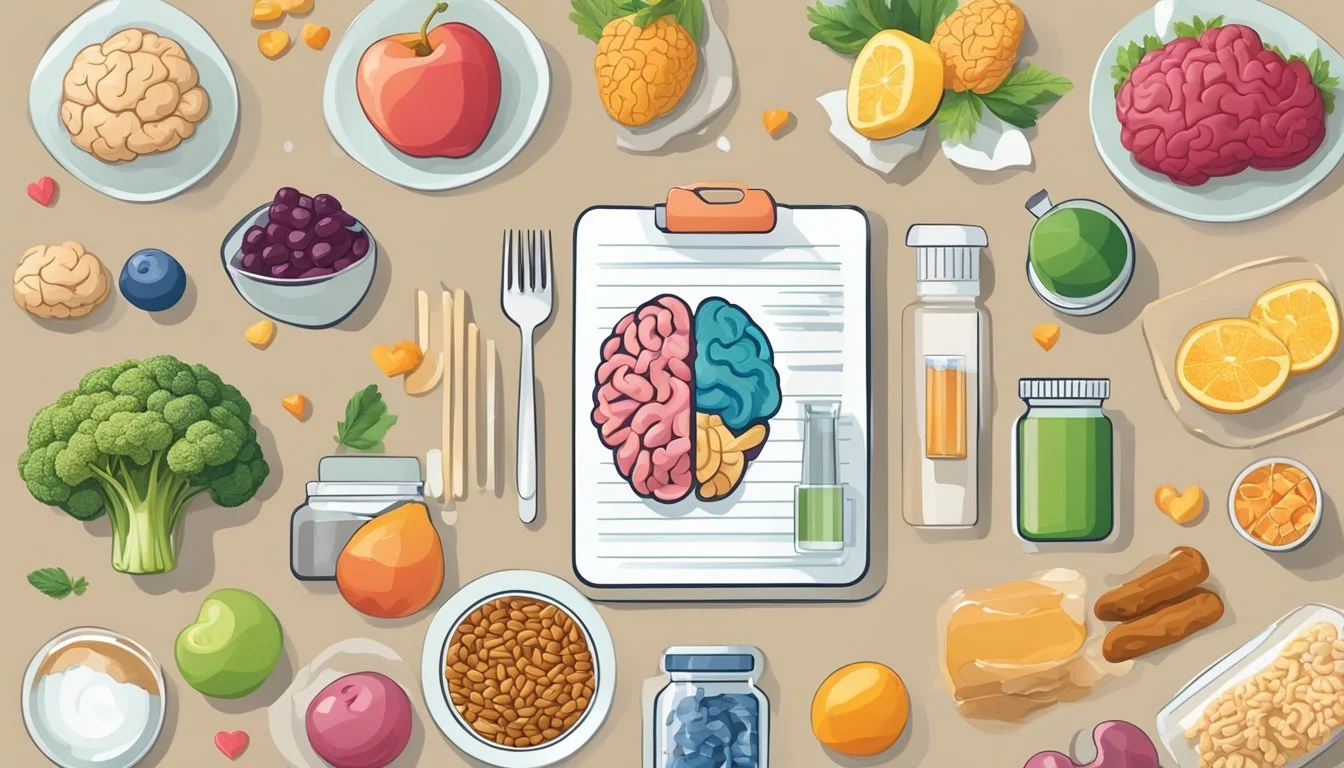Best Foods for Reducing the Risk of Stroke
A Nutritional Guide
Strokes stand as one of the leading causes of death and long-term disability globally, prompting a surge in preventive measures through nutrition and lifestyle adjustments. Studies indicate that key dietary habits may play a significant role in decreasing stroke risk. Widely endorsed by health professionals, a healthy diet rich in certain foods can form a cornerstone in stroke prevention strategies. By focusing on nutritional choices, individuals can influence several risk factors associated with stroke, including hypertension, cholesterol levels, and systemic inflammation.
To mitigate stroke risks, nutritionists often recommend a diet that prioritizes whole grains, fruits and vegetables, low-fat dairy, and lean meats. This aligns with the DASH (Dietary Approaches to Stop Hypertension) diet, which targets hypertension, a major stroke risk factor. Moreover, the inclusion of fatty fish such as salmon in meals several times a week provides beneficial omega-3 fatty acids, known for their role in reducing inflammation and contributing to vascular health.
Additionally, a well-balanced diet featuring foods like leafy greens that are high in dietary nitrates and vitamin C-rich fruits may further fortify the body's defenses against stroke. These nutrients support various bodily functions that help maintain optimal blood pressure and blood vessel integrity. As people integrate these dietary practices into their daily lives, they adopt a proactive approach to health that emphasizes the power of nutrition in stroke prevention.
Understanding Strokes and Risk Factors
Strokes are serious medical conditions involving the brain's blood vessels that require immediate attention and management to prevent long-term disability or death. It is essential to understand the types of strokes, risk factors, and the lifestyle choices that can mitigate these risks.
Types of Strokes
Strokes occur in two main forms: ischemic and hemorrhagic. Ischemic stroke, the most common type, happens when a blood clot obstructs a vessel supplying blood to the brain. Hemorrhagic stroke occurs when a blood vessel in the brain bursts, leading to bleeding within or around the brain.
Common Stroke Risk Factors
Several risk factors increase the likelihood of having a stroke. Key factors include high blood pressure (hypertension), high cholesterol, smoking, and diabetes. Conditions that affect blood flow, such as atrial fibrillation or artery diseases, also pose significant risks.
Impact of Lifestyle on Stroke Risk
Lifestyle choices have a profound effect on stroke risk. The American Heart Association recognizes poor diet, physical inactivity, and obesity as modifiable risk factors. By managing blood pressure, cholesterol levels, and smoking habits, individuals can significantly decrease their stroke risk.
Stroke Statistics in the United States
In the United States, stroke is a leading cause of death and long-term disability. The Centers for Disease Control and Prevention (CDC) reports that every year, more than 795,000 Americans suffer a stroke. High blood pressure is the leading cause of preventable strokes in the United States.
Nutritional Guidelines for Stroke Prevention
Nutrition plays a crucial role in reducing the risk of stroke. This section provides specific dietary guidelines endorsed by authoritative sources to help individuals tailor their eating habits for stroke prevention.
American Heart Association Recommendations
The American Heart Association (AHA) emphasizes the importance of a balanced diet to minimize stroke risk. Their guidelines recommend:
Fruits and Vegetables: Aiming for a variety of fruits and vegetables each day to take advantage of their antioxidant properties and high fiber content.
Whole Grains: Incorporating whole grains to increase dietary fiber and nutrient intake.
Healthy Proteins: Opting for healthy sources of protein like legumes, nuts, fish, and seafood; if consuming dairy, choosing low-fat options.
Limit Sodium and Saturated Fats: Reducing sodium intake to control blood pressure, and avoiding to consume food high in saturated fats.
Dietary Approaches to Stop Hypertension (DASH) Diet
The DASH diet offers another approach to reduce stroke risk, focusing on:
Lower Sodium: Consuming foods lower in sodium to assist in blood pressure management.
Nutrient-Rich Foods: Eating foods that are rich in potassium, magnesium, and calcium for cardiovascular health.
Varied Diet: Ensuring the diet includes whole grains, fruits, vegetables, and lean meats.
Mediterranean Diet
The Mediterranean diet is associated with a lower risk of cardiovascular disease and is beneficial for stroke prevention:
Heart-Healthy Fats: Utilizing olive oil as a primary fat source, which is rich in monounsaturated fats.
Plant-Based Foods: Basing the diet heavily on plant-based foods, including a vast array of vegetables and fruits, nuts, legumes, and whole grains.
Moderate Dairy and Meat: Including moderate amounts of dairy and consuming mostly lean cuts of poultry and fish, while limiting red meat.
Antioxidants and Flavonoids: A diet rich in these compounds, commonly found in fruits and vegetables, which are believed to help in reducing stroke risk.
Specific Foods That Reduce Stroke Risk
Incorporating a variety of specific foods into one's diet can significantly reduce the risk of stroke. The foods listed below are known for their beneficial properties, including the ability to improve cardiovascular health.
Beneficial Fruits and Vegetables
Fruits: Many fruits are rich in flavonoids, particularly citrus fruits like oranges. Studies have shown that flavonoids can lead to a reduction in stroke risk. Fruits high in vitamin C, such as oranges and pears, are recommended for their potential preventative effects.
Vegetables: Leafy green vegetables, including spinach, kale, and collard greens, are abundant in dietary nitrates. These compounds aid in maintaining healthy blood vessels, which is vital for stroke prevention. Other potassium-rich vegetables can also contribute to lowering stroke risk.
Whole Grains and Fiber-Rich Foods
Whole grains and other fiber-rich foods are essential for heart health and can reduce stroke risk. Whole grain cereals, brown rice, and oats are examples of fiber-dense foods that help manage blood pressure and cholesterol levels.
Nuts, Seeds, and Legumes
Nuts and seeds are excellent sources of omega-3 fatty acids and should be included in a heart-healthy diet. Almonds, walnuts, chia seeds, and flaxseeds are particularly beneficial. Legumes like beans and lentils provide not only omega-3s but also fiber, contributing to cardiovascular health and stroke prevention.
Lean Proteins and Fatty Fish
Including lean meats in your diet can aid in stroke risk reduction by providing essential proteins without high saturated fat. Fatty fish, such as salmon, is recommended for its omega-3 fatty acid content, which is linked to lower levels of inflammation, cholesterol, and blood pressure. Consuming two to three servings weekly is advocated to gain these protective benefits.
The Role of Healthy Fats and Antioxidants
In reducing stroke risk, understanding the role of healthy fats such as omega-3 fatty acids and the beneficial impact of antioxidants is crucial. These nutrients contribute to reducing inflammation and managing cholesterol levels.
Understanding Fats and Cholesterol
Saturated Fats:
Typically found in animal products and processed foods
Can contribute to higher levels of bad cholesterol (LDL)
Omega-3 Fatty Acids:
A type of polyunsaturated fat beneficial for heart health
Sources include fatty fish, flaxseeds, and walnuts
Help reduce inflammation and may lower the risk of chronic diseases, such as stroke
Monounsaturated Fats:
Found in foods like avocado, nuts, and olive oil
May help decrease bad cholesterol levels and improve heart health
To maintain healthy cholesterol levels and reduce stroke risk, one should prioritize the intake of monounsaturated and polyunsaturated fats over saturated fats.
Antioxidant-Rich Foods
Antioxidants work to combat oxidative stress, which can damage cells and contribute to the development of diseases, including stroke. Here are key antioxidants and their sources:
Flavonoids: These antioxidants are found in green tea, dark chocolate, and citrus fruits. They're associated with a lower risk of ischemic stroke.
Vitamin C, E, and Carotenoids: Abundant in a variety of fruits and vegetables, these antioxidants also play a role in stroke prevention.
Incorporating antioxidant-rich foods into one's diet can enhance the body's defenses against inflammation and related diseases.
Foods and Substances to Avoid
Making informed dietary choices is crucial in reducing the risk of stroke. Certain foods and substances, if consumed in high amounts, can lead to increased blood pressure, cholesterol levels, and other risk factors associated with strokes.
Reducing Salt and Sodium Intake
Salt and Sodium: High intake of salt and sodium can lead to hypertension, a major risk factor for stroke. Experts recommend limiting salt intake to less than 2,300 milligrams per day, with an ideal limit of no more than 1,500 milligrams for most adults.
Examples of high-sodium foods: Canned soups, frozen dinners, processed meats
Tips for reducing intake:
Choose fresh or frozen vegetables instead of canned.
Read nutrition labels to find low-sodium alternatives.
Use herbs and spices instead of salt to flavor meals.
Limiting Saturated Fat and Eliminating Trans Fat
Saturated and Trans Fats: These fats can increase levels of "bad" cholesterol in the blood, leading to clogged arteries. For heart health, it's advised to limit saturated fats to 5-6% of total daily calories and to avoid trans fats completely.
Sources of Saturated Fats: Red meat, butter, full-fat dairy products
Sources of Trans Fats: Partially hydrogenated oils found in some fried and processed foods
Minimizing Sugar and Added Sugars
Sugar Consumption: Excessive sugar intake, particularly added sugars, contributes to obesity and diabetes—both stroke risk factors. Reducing sugar-rich and processed foods can help manage weight and improve overall health.
High-Sugar Products: Sodas, sweets, pastries
Suggested Actions:
Opt for water or unsweetened beverages.
Choose fruits for natural sweetness.
Alcohol and Stroke Risk
Alcohol Intake: While moderate alcohol consumption may have some health benefits, excessive drinking can increase blood pressure and the risk of stroke. Moderation is defined as up to one drink per day for women and two for men.
Concerns:
Heavy alcohol use can lead to multiple health issues including stroke.
Some alcoholic beverages have high-calorie content contributing to weight gain.
The Risks of Processed Meats
Processed Meats: These products often contain high levels of salt and preservatives, which can contribute to high blood pressure and stroke risk. Limiting consumption of processed meats can be beneficial for stroke prevention.
Examples: Bacon, sausages, deli meats
Advantages of reducing processed meats: Decreased risk of stroke, lower blood pressure
By monitoring and reducing the intake of these foods and substances, individuals may lower their risk of suffering a stroke.
Diet and Lifestyle Synergy
Integrating a healthy diet with regular exercise is essential for potentially reducing the risk of stroke and promoting overall cardiovascular health. Both components work together to support body function and reduce risk factors associated with stroke.
Physical Activity and Exercise
Regular physical activity, such as aerobic exercises, including brisk walking, cycling, or swimming, can have profound effects on one's health. It strengthens the cardiovascular system and can lower blood pressure, one of the key risk factors for stroke. It's recommended that individuals engage in at least 150 minutes of moderate-intensity exercise per week.
Recommended Activities:
Aerobic exercises: 3–5 days a week
Muscle-strengthening activities: at least 2 days a week
Incorporating physical exercise into one's lifestyle can improve body weight control and enhance metabolic health, both of which contribute significantly to stroke risk reduction.
Healthy Eating Habits
A diet featuring nutrient-rich foods supports overall health and can lower stroke risk. Research suggests consuming:
Fruits and Vegetables: A variety of colorful fruits and vegetables, particularly citrus fruits and leafy greens. These are high in dietary fiber and antioxidants.
Whole Grains: Foods such as brown rice, oats, and whole wheat bread.
Lean Proteins: Including chicken, tofu, and fish that are rich in omega-3 fatty acids.
Unsaturated Fats: Sources like olive oil and avocados offer heart-healthy fats.
Regular intake of flavonoid-rich foods, like citrus fruits, has been associated with a reduced risk of ischemic stroke. Moreover, healthy eating habits should involve limiting the intake of sodium, added sugars, and saturated fats. Nutritional choices and portion control are instrumental in maintaining a healthy diet, which concurrently supports a healthy lifestyle and augments the benefits gained from regular physical activity.
Practical Tips for Dietary Changes
Implementing dietary changes requires a well-thought-out plan and an understanding that these adjustments frequently involve both what you eat and how you eat. The following strategies are instrumental in making sustainable changes to reduce the risk of stroke.
Meal Planning and Grocery Shopping
When it comes to reducing stroke risk, planning is key. Individuals should focus on a diet rich in fruits, vegetables, nuts, whole grains, and healthy fats. Creating a meal plan that incorporates these items can streamline grocery shopping and ensure that healthy choices are always available at home.
Fruits & Vegetables: Aim for a colorful variety, which can include leafy greens, berries, and citrus fruits for their flavonoids.
Nuts: A small handful of unsalted nuts can be an excellent snack or salad topping.
Whole Grains: Choose whole-grain breads, pastas, and cereals over refined options.
Healthy Fats: Opt for unsaturated fats found in olive oil, avocados, and certain fish like salmon.
Cooking and Meal Preparation
Preparing meals at home allows for control over ingredients, making it easier to limit sodium and unhealthy fats, which are often high in processed foods. Incorporate lean proteins such as tofu or chicken into the diet and utilize cooking methods like grilling, steaming, or baking instead of frying.
Lean Proteins: Include options like chicken breast, tofu, or fish.
Cooking Methods: Prioritize baking, steaming, or grilling over frying to reduce fat intake.
Mindful Eating Strategies
Mindful eating involves being aware of what and how much one eats, taking the time to savor food, and listening to hunger cues. It helps in portion control and ensures that individuals make more thoughtful food choices, contributing to better nutrition and lifestyle changes.
Awareness: Recognize hunger and fullness signals to avoid overeating.
Savor: Take the time to chew thoroughly and enjoy the flavors of healthier food options.
Supplements and Stroke Risk
It is essential to consider the potential benefits and limitations of supplements in stroke prevention. Research indicates that certain supplements, particularly those containing omega-3 fatty acids and specific vitamins and minerals, may have a positive impact on reducing the risk of stroke.
Fish Oil and Omega-3 Supplements
Omega-3 fatty acids are well-regarded for their anti-inflammatory and anti-thrombotic (anticoagulant) properties. These essential fats cannot be produced by the body and must be obtained through diet or supplementation. Studies suggest that fish oil supplements, which are rich in omega-3 fatty acids like EPA and DHA, could lower the risk of stroke by improving blood lipid profiles and potentially reducing arterial plaque formation.
Fish oil and omega-3 supplements come in various concentrations, and the recommendation often emphasizes high-quality sources. It's important for individuals to adhere to dosage guidelines and consult healthcare professionals prior to starting any supplement regimen.
Vitamin and Mineral Supplements
Consumption of certain vitamins and minerals through supplements may contribute to stroke risk reduction, specifically antioxidants such as vitamin C and vitamin E which help combat oxidative stress and inflammation, both of which are risk factors for stroke. Additionally, B-vitamin complex supplements, including folate (vitamin B9), vitamin B6, and vitamin B12, have been studied for their role in lowering homocysteine levels, an amino acid linked to higher stroke risk when present in elevated amounts.
Here's a brief look at the role of each:
Vitamin C: Antioxidant properties, supporting vascular health.
Vitamin E: May help to prevent blood clots.
B Vitamins: Contribute to the reduction of homocysteine levels.
It is critical to note that while supplements can aid in stroke risk reduction, they are not a replacement for a healthy diet and lifestyle. Individuals should prioritize getting these nutrients from natural food sources and speak with a healthcare provider to tailor a supplement plan to their specific health needs.
Conclusion
Maintaining a healthy lifestyle through conscious diet and nutrition choices is essential in reducing the risk of stroke. Individuals are recommended to incorporate foods that are nutritious and can contribute to overall cardiovascular health.
Fruits and vegetables, especially those rich in vitamin C, should be staples in one's diet. They provide antioxidants that support vascular health. Leafy greens such as spinach and kale, due to their dietary nitrates, are particularly beneficial.
Whole grains and low-fat dairy options contribute to a balanced eating pattern, while lean meats provide necessary protein without excessive saturated fat. Limiting sodium and avoiding processed meats can help manage blood pressure, a significant stroke risk factor.
Inclusion of fatty fish, like salmon, provides omega-3 fatty acids, which have been linked to reduced inflammation and improved blood lipid profiles. The ripple effect of these dietary habits as one ages can be profound in stroke prevention.
Regular exercise complements a stroke-preventive diet, enhancing the benefits of good nutrition by keeping the body active and the blood vessels in better condition. A combination of diet and physical activity fortifies the body's defense against the onset of stroke.
Empowering individuals to make these healthy choices consistently forms the cornerstone of effective stroke prevention. As each person's health context is unique, consultation with healthcare professionals for personalized advice is advisable.






